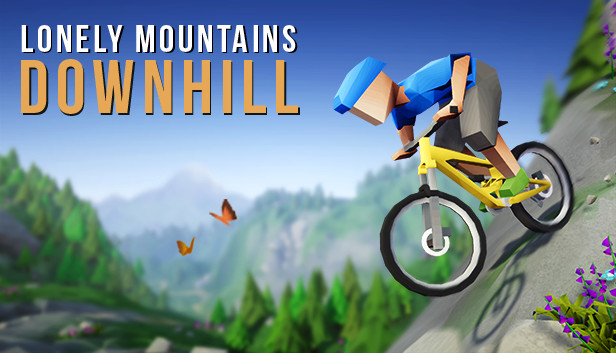[Review]: Lonely Mountains: Downhill – Nintendo Switch
Lonely Mountains: Downhill – Nintendo Switch
Developed By: Megagon Industries
Published By: Thunderful
Category: Mountain Bike Trial, Racing
Release Date: May 07, 2020
As you start atop the mountain, there is a moment of zen. No cars, no other people, no noise pollution from civilisation. Your in-game biker rider likely has their phone left behind safely in their tent, as they are about to start a dangerous journey to the bottom of a mountain. Any distractions could prove fatal for the rider, and their phone.
Lonely Mountains: Downhill makes you feel like you are out there in the mountains, on your own, just you and the mountain. It is a great advert for the great outdoors, the excellent sound design hits the right notes that evoke the same feelings in me whenever I manage to get out there myself. There is no pumping rawk soundtrack which you might expect in a game like this. The only tunes you hear sung are by the wind as it billows through the trees and the native in-game wildlife, like something out of an ASMR soundtrack.
This is the work of somewhat ironically named German developer Megagon Industries and Swedish indie super-publisher Thunderful. Lonely Mountains: Downhill was originally a Kickstarter and the developers wanted to create a different kind of sports game, inspired by daring mountain bike maestros Danny MacAskill and Kenny Balaey, where it is you against the environment, and against yourself.
The core experience is a time trial; get to the finish line as fast as you can. The camera is in a fixed position, and moves around your cyclist as you descend each mountain trail. At times trees can obscure your view which feels like it unnecessarily adds to the game’s difficulty. But the controls are tight providing an unparalleled feeling of control, which is vital when there is such a small margin of error.
Each mountain has a set path which, much like any other racing game, is the fastest terrain to ride on. But there are multiple other routes; some are shortcuts, some less so. Each trail has checkpoints so when your biker crashes, you restart at the last checkpoint you passed. Following a crash your restart is instantaneous, which encourages you to experiment with different routes or taking sections at different speeds. On subsequent playthroughs, checkpoints tell you your time in the last section and how it compares to your personal best which is essential when you take on a challenge to beat a trail in under a certain time.
When you first encounter a new trail the only objective you have is to reach the bottom of the mountain with no timer tracking your time. This is an effective way to be introduced to each new trail, as it’s almost like a sandbox-type mode where you can make you way down the mountain while looking for any hidden shortcuts.
After you make it down a trail for the first time, you unlock the Beginner challenges which usually are to complete it in a certain time or with crashing no more than a certain number of times. Completing those unlocks the Expert challenges which are more of the same but faster completion times and fewer crashes. Completing Expert challenges unlocks the Free Rider challenge which is get to the bottom of the mountain with no crashes. This is a real test of your memorisation of the trail and skills to this point and your reward for this is Night mode, which is the ultimate test. It is as it sounds, with only your bike light lighting your way down the mountain. Almost as tense are the sheer drops from the cliffs of Hells Spire which are enough to induce acrophobia, with one mistake spelling certain death for your in-game rider.
New trails are unlocked by completing a challenge on the current trail, and completing other challenges also unlocks paint jobs for your bike, new outfits for your rider and bike parts which is currency you use to unlock the other bikes. Each bike has different strengths across a range of attributes you might expect in a racing game such as grip, speed and acceleration. Here other attributes such as stability and shock absorption influence how easy it is for your rider to stay on their bike when hitting obstacles or when jumping and landing from a height. Lonely Mountains: Downhill challenges you to experiment with different bikes to find the one optimal for the situation.
Visually, it has a lovely abstract polygonal art style, your rider looking like something that could have walked out of an HD version of SNES classic Starfox. Some of the environments look like they were made out of paper mache, with trees from cardboard. The use of depth of field at times is nice and draws focus back to your rider and away from the distraction of the natural, yet angular beauty all around. Shadows can look very pixelated which is noticeable when trees cast a shadow over the path. This isn’t the first time we’ve seen this concession in a Switch conversion, but this is not enough to spoil the party as you race past them. Performance is generally smooth in handheld and docked, with minimal slowdown. There are times when the game loads at random midway through a trail which causes the screen to jerk momentarily which is unfortunate when this happens at crucial moments.
Lonely Mountains: Downhill caters to most levels of players, challenging you to shave time off your personal best, or manage a perfect run down to the bottom with no crashes. Online leaderboards are well implemented allowing you to see how you rank against other players for each trail completed. Most will manage the Beginner challenges and the number of other challenges are enough to keep you coming back for more across its 16 trails. While the beauty of this as a solitary experience is clear, it would have been nice if Megagon had given players the chance to race down the mountain with another player.
Rarely do you encounter a game which provokes such a feeling of contrasting emotions. The calm you feel at the top of the mountain fades as you take the plunge down the next exhilarating trail. You will encounter setbacks on tricky sections and there will be some frustration but for the most part it is never the game’s fault, barring occasional sensitive physics when you brush some debris. The game enables you to experiment and take risks without it feeling like you’re being punished for doing so. The elation felt when you manage to crack a challenging section or find a way to shave time off your personal best is hugely satisfying. Then the calm returns, until the next challenge.
4/5





Buy Lonely Mountains: Downhill
Be sure to follow Thunderful

Also, be sure to follow Megagon Industries









